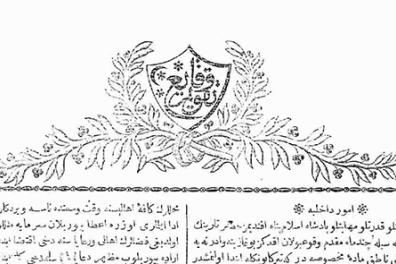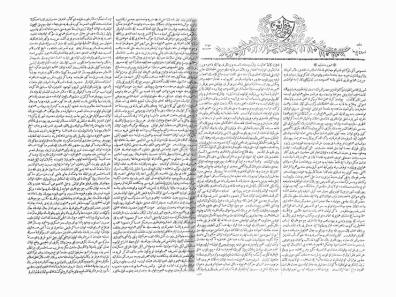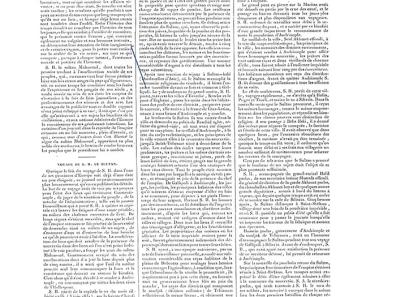Ottoman language and politics in the 19th century

But it's a written medium containing a large number of texts that are the expression of a collective political thought in motion and in the process of elaboration, betraying many conceptual and terminological gropings.
The birth of a whole new way of thinking
Through tumultuous episodes, from the turn of the 19th century to the 1830s, this new thinking and political language, which are those of the reformism of the time of Selim III (r. 1789-1807), mature for more or less forty years. It was the linguistic expression of a new paradigm of the relationship between power and the population over which it exercised its authority. From 1826, the date of the destruction of the janissaries, this political thought gradually gave birth to a new configuration of power, and inevitably, a new political language to express it.
In practical terms, it's a system based on the rights and obligations of individuals, defined and protected by sharia and tradition, under the guarantee of three centers of counter-power (the ulama, the janissaries and the regional potentates). The palace wanted to move to a system where the sultan could redefine rights and obligations in such a way as to mobilize the population as much as possible. In other words, central power no longer wanted to be limited or controlled by intermediate bodies. The contours of this new configuration of power, as well as the political discourse that accompanies, frames and extends it, are outlined in the pages of the Takvîmi vekayi' and its French edition.

Creation of a new political vocabulary
Three terms and their derivations mark this new political language: nizâm (order, discipline) with some of its grammatical derivations (nizâmât, nizâmiye, tanzîm meaning regulations, regular, reorganization respectively), usûl (manner, method, procedure, principle) and cedîd (new) as well as its derivations müceddid, tecdîd and teceddüdât (renovator/regenerator, renewal, renovations). The first two terms, nizâm and usûl, often appear in the context of an associative relationship with some positive qualifiers (hüsn, müstahsen, hasene / hayriye / behiye). It should be noted that these first three qualifiers are from the same Arabic root as the term istihsân which is an important concept in Ottoman political philosophy whose French translation would be "bien-être public".
Beyond the deployment of the term cedîd as well as its derivations, the novelty of this new political regime is constantly emphasized by the editors of the Ottoman Monitor. Numerous temporal markers are found in the texts of the official gazette: öteden beri (since always), evvelki gibi (as it used to be); şimdiye kadar (until now); usûlden olmuş idi (as it used to be), eski usûllerinin tebdîliyle (changing their former usages); usûl-i sâbıkalarının tebdîliyle müceddeden tanzîm (they were reorganized following the change in their previous usages), usûl ve nizâmât-ı atîkasının dahi tecdîd (the renovation of their old principles and regulations) or icrâsı mu'tâd olan (as was customary). The novelties introduced are described as "never having been seen or heard of" (bir vakitte görülüp işidilmemiş olmağla).

Very present temporal markers
These temporal markers, which seem quite banal at first glance, actually have a fundamental rhetorical function in shaping the political discourse of the Takvîm-i vekayi'. Of course, every language contains temporal markers, and every tradition of bureaucratic phraseology makes abundant use of them. But this is so trivial that it is often overlooked in studies of historical semantics. However, in the case of the official Ottoman gazette, this choice to mark, to emphasize novelty and change, reflects a new relationship with time: the present is distinguished, increasingly detached, from what precedes it.
Stressing novelty by contrasting it with the old does not necessarily involve the use of temporal markers either. Sometimes, the novelty of the practice introduced is expressed by innocuous discourse markers. Specifically, these are the argumentative connectors ise de (even though) and iken (while), which serve to emphasize the contrast with previous usages and consequently to articulate and accentuate the novelty of the introduced practice.
A political discourse is formed, reformed, articulated not only by the changes made through and in conceptual terminology but also by the more usual lexical elements, the most ordinary grammatical combinations as well as the figures of speech commonly, knowingly and unconsciously used. A close reading of Takvîm-i vekayi' leads to the conclusion that, alongside key word-concepts, the grammatical and discursive markers through which the argumentative strategy of the editors of the official gazette is concretized must also absolutely be taken into consideration in the analysis of political language. In the case of Ottoman Turkish, the very high frequency of recourse to hendiadys and lexical collocations of various forms is not an anecdotal detail but constitutes, on the contrary, the methodological starting point for the historian who is interested in the meanings of the texts he studies in a philological approach.
This is why a detailed knowledge of prefabricated expressions and great vigilance with regard to their pragmatic anchoring, i.e. their function in a specific context of use, must constantly guide the historian in the interpretation of these texts.
If it is not possible for a historian to have all the skills of a researcher in literary or linguistic studies, this state of affairs must nevertheless lead him to be attentive to the rhetorical and linguistic aspects of the discursive construction of the texts he analyzes, and above all to favor caution and generate humility in his conclusions so as not to over- or misinterpret the semantic load of his corpus.
Özgür Türesay
Maître de conférences en sciences historiques et philologiques
UMR 7192 -Proche-Orient, Caucase, langues, archéologie, cultures (PROCLAC) - EPHE, PSL
BIBLIOGRAPHY
Beydilli, Kemal (1999), "Küçük Kaynarca'dan Tanzimât'a Islâhât Düşünceleri", İlmî Araştırmalar 8, pp. 25-64.
Karateke, Hakan (2015), "The Ottoman Official Gazette Taqvim-i Veqayi, 1831: An Ottoman Annal in its Own Right", in Bill Hickmann, Gary Leiser (eds.), Turkish Language, Literature, and History: Travelers' Tales, Sultans, and Scholars Since the Eighth Century, Routledge, pp. 191-207.
Koloğlu, Orhan (1989), İlk Gazete İlk Polemik. Vekayi-i Mısriye'nin Öyküsü ve Takvimi Vekayi İle Tartışması, Ankara, Çağdaş Gazeteciler Derneği Yayınları.
Koloğlu, Orhan [1981], Takvimi Vekayi. Türk Basınında 150 Yıl, 1831-1981, Ankara, Çağdaş Gazeteciler Derneği Yayınları.
Koloğlu, Orhan (1994), "İlk Gazetelerimiz Aracılığıyla (1828-1867) Dilimize Giren Batı Kavram ve Sözcükleri", in XI. Türk Tarih Kongresi, Ankara, 5-9 Eylül 1990, Kongre'ye Sunulan Bildiriler, Ankara, vol. 4, TTK, pp. 1645-1664.
Koloğlu, Orhan (1992), "Le premier journal officiel en français à Istanbul et ses répercussions en Europe", in Nathalie Clayer, Alexander Popovic, Thierry Zarcone (eds.), Presse turque et presse de la Turquie, Istanbul, Éditions Isis, pp. 3-13.
Koloğlu, Orhan (1991), "Blak Bey, précurseur du Tanzimat. Une famille française au service de la Sublime Porte (1820-1923)", Anatolia Moderna, 1, pp. 47-114.
Koloğlu, Orhan (1986), "Alexandre Blacque. Défenseur de l'État ottoman par amour des libertés", in Hâmit Batu and Jean-Louis Bacqué-Grammont (eds.), L'Empire ottoman, la République de Turquie et la France, Istanbul, Éditions Isis, pp. 179-195.
Römer, Claudia (2002), "Quelques remarques sur la langue journalistique ottomane d'avant 1876 selon des textes tirés des journaux Takvim-i vakayi, Ceride-i havadis, Ruzname-i ceride-i havadis et Tasvir-i efkâr", in Hans-Lukas Kieser (ed.), Aspects of Political Language in Turkey (19th-20th Centuries), Istanbul, İSİS, pp. 53-60.
Sariyannis, Marinos (2019), A History of Ottoman Political Thought up to the Early Nineteenth Century, Leiden-Boston, Brill.
Saussure, Ferdinand de (1971 [1916]), Cours de linguistique générale, Paris, Payot.
Schmale, Günter (2013), "What is prefabricated in language? - Réflexions au sujet d'une définition élargie de la préformation langagière", Langages 189, pp. 27-45.
Somolinos, Amalia Rodríguez (2011), "Presentation: discourse markers - contrastive approaches", Langages 184, pp. 3-12.
Şakul, Kahraman (2005), "Nizâm-ı Cedid düşüncesinde batılılaşma ve İslami modernleşme", Dîvân İlmî Araştırmalar 19/2, pp. 117-150.
Yaycıoğlu, Ali (2018), "Guarding Traditions and Laws - Disciplining Bodies and Souls: Tradition, science and religion in the age of Ottoman reform", Modern Asian Studies 52/5, pp. 1542-1603.
Yazıcı, Nesimi (1983), Takvim-i Vekayi. Belgeler, Ankara, Gazi Üniversitesi.